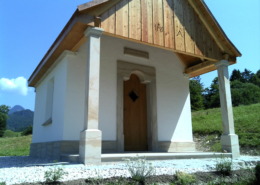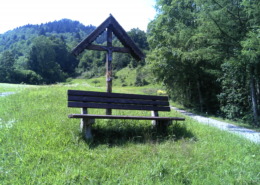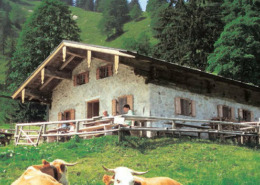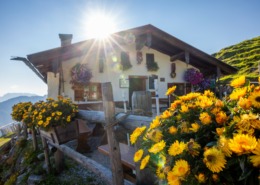River and moor hike through the Achental
River and moor hike through the Achental

River and moor hike through the Achental
distance
duration
highest point
meters upwards
meters downwards
Difficulty
easy
The starting point of the tour is the town hall in Marquartstein. We start in the direction of Bahnhofstrasse, where we walk a few meters on the footpath towards Schleching. Shortly before the new traffic island at Wuhrbichl we turn right and follow the road past houses, which turns into a path. We follow this path to the intersection, where we turn left towards Oed. From Oed the path goes along the edge of the forest to Holzen, where we then follow the sign towards Donau. We pass the “Lanzinger Moos” nature reserve and reach Donau. At the end of Donau we turn left along the road and immediately right again, following the sign towards Raiten and then walk along the Tiroler Ache. At the next bridge we cross the road, continue straight on next to the Tiroler Ache and past open meadows that serve as retention basins in the event of flooding. In the forest we turn left and continue the hike next to the Tiroler Ache towards Schleching on the Achendammweg. The path becomes increasingly narrower and goes uphill until we reach the highest point, where surefootedness is required for a few meters. A rope helps us to cross this point, before a few steps take us back to the Ache. Shortly after a wooden bridge over the stream, we turn left again onto the forest path along the Tiroler Ache until we reach the mouth of the Mühlbach, where we turn right towards Mühlau and arrive at the car park. Now we go right towards Raiten and past a moorland area, the “Mettenhamer Filz”. Open spaces alternate with forest left to nature. Right at the start of Raiten we go left uphill to the pilgrimage church of the seven linden trees and past this in the direction of Hinterraiten. We come to the Engerait/Emperbichlstraße junction, go right downhill and continue our hike along the main road towards Marquartstein via Süssen and then to Holzen. We should interrupt the hike at the chapel, which was dedicated to St. Wolfgang, to take a worthwhile look inside. At the next signpost, we turn right towards Holzen. Shortly before Holzen, we turn left towards Dicking and at Minaruh it is worth spending a few minutes on the bench. We then continue right towards Marquartstein (without Wuhrbichl). After a few meters, we turn left towards Streunthal, walk past the hut and farm until we reach Lanzinger Strasse. Here we cross the street and walk along the footpath towards the church and then to our starting point at the town hall in Marquartstein. Refreshment options: Raitner Wirt (Raiten), Bonbon und Keksi (Mettenham) (please note the opening times).
Einkehrmöglichkeit
Parkplatz Rathaus
 https://www.achental.com/en/storage/sites/10/2024/11/3cBMJGbVQjuArEHVWDZYZ3qcFakrOd8IToiuQfwm-scaled.jpg
1707
2560
admin
https://www.achental.com/wp-content/uploads/2022/07/achental-logo-weiss-horizontal-RGB@2x.png
admin2024-11-06 09:24:352024-11-11 12:09:02Piesenhausener Hochalm
https://www.achental.com/en/storage/sites/10/2024/11/3cBMJGbVQjuArEHVWDZYZ3qcFakrOd8IToiuQfwm-scaled.jpg
1707
2560
admin
https://www.achental.com/wp-content/uploads/2022/07/achental-logo-weiss-horizontal-RGB@2x.png
admin2024-11-06 09:24:352024-11-11 12:09:02Piesenhausener Hochalm https://www.achental.com/en/storage/sites/10/2024/11/53357_DSC00015.jpg
1536
2048
admin
https://www.achental.com/wp-content/uploads/2022/07/achental-logo-weiss-horizontal-RGB@2x.png
admin2024-10-28 11:30:442024-11-11 12:20:54Lake Taubensee via Luftboden- and Kroatensteig
https://www.achental.com/en/storage/sites/10/2024/11/53357_DSC00015.jpg
1536
2048
admin
https://www.achental.com/wp-content/uploads/2022/07/achental-logo-weiss-horizontal-RGB@2x.png
admin2024-10-28 11:30:442024-11-11 12:20:54Lake Taubensee via Luftboden- and Kroatensteig https://www.achental.com/en/storage/sites/10/2024/11/54048_DSC00077.jpg
1536
2048
admin
https://www.achental.com/wp-content/uploads/2022/07/achental-logo-weiss-horizontal-RGB@2x.png
admin2024-10-28 11:30:432024-11-11 11:56:05Chiemseeblick und Kruchenhausener Runde
https://www.achental.com/en/storage/sites/10/2024/11/54048_DSC00077.jpg
1536
2048
admin
https://www.achental.com/wp-content/uploads/2022/07/achental-logo-weiss-horizontal-RGB@2x.png
admin2024-10-28 11:30:432024-11-11 11:56:05Chiemseeblick und Kruchenhausener Runde https://www.achental.com/en/storage/sites/10/2024/11/CDTMsg4Hb2DS5BtnZcYGmBuAfCyveA4EbBoRaaeb-scaled.jpg
1840
2560
admin
https://www.achental.com/wp-content/uploads/2022/07/achental-logo-weiss-horizontal-RGB@2x.png
admin2024-10-28 11:30:232024-11-11 12:00:51Valley circular trail
https://www.achental.com/en/storage/sites/10/2024/11/CDTMsg4Hb2DS5BtnZcYGmBuAfCyveA4EbBoRaaeb-scaled.jpg
1840
2560
admin
https://www.achental.com/wp-content/uploads/2022/07/achental-logo-weiss-horizontal-RGB@2x.png
admin2024-10-28 11:30:232024-11-11 12:00:51Valley circular trail https://www.achental.com/en/storage/sites/10/2024/11/VVT8YD8z5ZEAzoiXkshUne9HdSbxdwHaAkTvV3bW-scaled.jpg
1919
2560
admin
https://www.achental.com/wp-content/uploads/2022/07/achental-logo-weiss-horizontal-RGB@2x.png
admin2024-10-28 11:30:222024-11-11 12:00:15Grießelberg-Rundweg
https://www.achental.com/en/storage/sites/10/2024/11/VVT8YD8z5ZEAzoiXkshUne9HdSbxdwHaAkTvV3bW-scaled.jpg
1919
2560
admin
https://www.achental.com/wp-content/uploads/2022/07/achental-logo-weiss-horizontal-RGB@2x.png
admin2024-10-28 11:30:222024-11-11 12:00:15Grießelberg-Rundweg https://www.achental.com/en/storage/sites/10/2024/11/9VruSXPV8ePSxZlnGpViGMZqYnWT2WmVj6N21gVK.webp
768
576
admin
https://www.achental.com/wp-content/uploads/2022/07/achental-logo-weiss-horizontal-RGB@2x.png
admin2024-10-28 11:30:192024-11-11 11:57:18Feldlahnalm tour
https://www.achental.com/en/storage/sites/10/2024/11/9VruSXPV8ePSxZlnGpViGMZqYnWT2WmVj6N21gVK.webp
768
576
admin
https://www.achental.com/wp-content/uploads/2022/07/achental-logo-weiss-horizontal-RGB@2x.png
admin2024-10-28 11:30:192024-11-11 11:57:18Feldlahnalm tour https://www.achental.com/en/storage/sites/10/2024/11/dnnXUqmOoT9qsZJ2w9KjLhaU9rm1fN1Pzba35MkA.jpg
1500
1000
admin
https://www.achental.com/wp-content/uploads/2022/07/achental-logo-weiss-horizontal-RGB@2x.png
admin2024-10-28 11:30:172024-11-11 12:05:36Kneipp circular tour
https://www.achental.com/en/storage/sites/10/2024/11/dnnXUqmOoT9qsZJ2w9KjLhaU9rm1fN1Pzba35MkA.jpg
1500
1000
admin
https://www.achental.com/wp-content/uploads/2022/07/achental-logo-weiss-horizontal-RGB@2x.png
admin2024-10-28 11:30:172024-11-11 12:05:36Kneipp circular tour https://www.achental.com/en/storage/sites/10/2024/11/89256_DSC00025.jpg
1536
2048
admin
https://www.achental.com/wp-content/uploads/2022/07/achental-logo-weiss-horizontal-RGB@2x.png
admin2024-10-25 15:47:522024-11-11 12:11:00Circular hike Hinterwössen
https://www.achental.com/en/storage/sites/10/2024/11/89256_DSC00025.jpg
1536
2048
admin
https://www.achental.com/wp-content/uploads/2022/07/achental-logo-weiss-horizontal-RGB@2x.png
admin2024-10-25 15:47:522024-11-11 12:11:00Circular hike Hinterwössen https://www.achental.com/en/storage/sites/10/2024/11/sI0JyHhoSTI8r8TCYiee1ydZojiMieRrirnifIF6-scaled.jpg
1707
2560
admin
https://www.achental.com/wp-content/uploads/2022/07/achental-logo-weiss-horizontal-RGB@2x.png
admin2024-10-25 15:47:352024-11-11 11:52:40Auf historischen Pfaden
https://www.achental.com/en/storage/sites/10/2024/11/sI0JyHhoSTI8r8TCYiee1ydZojiMieRrirnifIF6-scaled.jpg
1707
2560
admin
https://www.achental.com/wp-content/uploads/2022/07/achental-logo-weiss-horizontal-RGB@2x.png
admin2024-10-25 15:47:352024-11-11 11:52:40Auf historischen Pfaden https://www.achental.com/en/storage/sites/10/2024/11/88876_Logo_Bergwalderlebnisweg_Specht.jpg
416
500
admin
https://www.achental.com/wp-content/uploads/2022/07/achental-logo-weiss-horizontal-RGB@2x.png
admin2024-10-25 15:43:432024-11-11 11:53:03Bergwalderlebnisweg Staffen
https://www.achental.com/en/storage/sites/10/2024/11/88876_Logo_Bergwalderlebnisweg_Specht.jpg
416
500
admin
https://www.achental.com/wp-content/uploads/2022/07/achental-logo-weiss-horizontal-RGB@2x.png
admin2024-10-25 15:43:432024-11-11 11:53:03Bergwalderlebnisweg Staffen https://www.achental.com/en/storage/sites/10/2024/11/88895_Staudacher_Alm.jpg
353
621
admin
https://www.achental.com/wp-content/uploads/2022/07/achental-logo-weiss-horizontal-RGB@2x.png
admin2024-10-25 15:43:292024-11-11 12:26:16Hike to Staudacher Alm
https://www.achental.com/en/storage/sites/10/2024/11/88895_Staudacher_Alm.jpg
353
621
admin
https://www.achental.com/wp-content/uploads/2022/07/achental-logo-weiss-horizontal-RGB@2x.png
admin2024-10-25 15:43:292024-11-11 12:26:16Hike to Staudacher Alm https://www.achental.com/en/storage/sites/10/2024/11/51266_Bank_mit_Aussicht_-_Minaruh-scaled.jpg
1714
2560
admin
https://www.achental.com/wp-content/uploads/2022/07/achental-logo-weiss-horizontal-RGB@2x.png
admin2024-10-01 17:50:352024-11-11 11:58:07River and moor hike through the Achental
https://www.achental.com/en/storage/sites/10/2024/11/51266_Bank_mit_Aussicht_-_Minaruh-scaled.jpg
1714
2560
admin
https://www.achental.com/wp-content/uploads/2022/07/achental-logo-weiss-horizontal-RGB@2x.png
admin2024-10-01 17:50:352024-11-11 11:58:07River and moor hike through the Achental https://www.achental.com/en/storage/sites/10/2024/11/Te2tS4q2ZNk5iEXddzTbag4xoStiEYcopEfwl9o0-scaled.jpg
1707
2560
admin
https://www.achental.com/wp-content/uploads/2022/07/achental-logo-weiss-horizontal-RGB@2x.png
admin2024-10-01 17:50:342024-11-11 11:51:38Almwanderung zur Rechenberg-Alm
https://www.achental.com/en/storage/sites/10/2024/11/Te2tS4q2ZNk5iEXddzTbag4xoStiEYcopEfwl9o0-scaled.jpg
1707
2560
admin
https://www.achental.com/wp-content/uploads/2022/07/achental-logo-weiss-horizontal-RGB@2x.png
admin2024-10-01 17:50:342024-11-11 11:51:38Almwanderung zur Rechenberg-Alm https://www.achental.com/en/storage/sites/10/2024/11/EH3CPTXurhRqZOwEUt1orWVrTFXkfhD2LU1KWGzY-scaled.jpg
1708
2560
admin
https://www.achental.com/wp-content/uploads/2022/07/achental-logo-weiss-horizontal-RGB@2x.png
admin2024-10-01 17:50:332024-11-11 12:11:39Circular tour to Marquartstein castle and river Tiroler Ache dam
https://www.achental.com/en/storage/sites/10/2024/11/EH3CPTXurhRqZOwEUt1orWVrTFXkfhD2LU1KWGzY-scaled.jpg
1708
2560
admin
https://www.achental.com/wp-content/uploads/2022/07/achental-logo-weiss-horizontal-RGB@2x.png
admin2024-10-01 17:50:332024-11-11 12:11:39Circular tour to Marquartstein castle and river Tiroler Ache dam https://www.achental.com/en/storage/sites/10/2024/11/N2bNvLXAlAVqBVUmhM8WBwzY1qUKdpLbN0RQxYkn-scaled.jpg
1707
2560
admin
https://www.achental.com/wp-content/uploads/2022/07/achental-logo-weiss-horizontal-RGB@2x.png
admin2024-10-01 17:50:322024-11-11 12:12:18Circular trail Zeppelinhöhe
https://www.achental.com/en/storage/sites/10/2024/11/N2bNvLXAlAVqBVUmhM8WBwzY1qUKdpLbN0RQxYkn-scaled.jpg
1707
2560
admin
https://www.achental.com/wp-content/uploads/2022/07/achental-logo-weiss-horizontal-RGB@2x.png
admin2024-10-01 17:50:322024-11-11 12:12:18Circular trail Zeppelinhöhe https://www.achental.com/en/storage/sites/10/2024/11/eF5RWwpHLyZRBXIEDfQQZANZgDDIFpK9upEuLTMb-scaled.jpg
1919
2560
admin
https://www.achental.com/wp-content/uploads/2022/07/achental-logo-weiss-horizontal-RGB@2x.png
admin2024-10-01 17:50:312024-11-11 12:10:05Around Marquartstein castle
https://www.achental.com/en/storage/sites/10/2024/11/eF5RWwpHLyZRBXIEDfQQZANZgDDIFpK9upEuLTMb-scaled.jpg
1919
2560
admin
https://www.achental.com/wp-content/uploads/2022/07/achental-logo-weiss-horizontal-RGB@2x.png
admin2024-10-01 17:50:312024-11-11 12:10:05Around Marquartstein castle https://www.achental.com/wp-content/uploads/2022/07/achental-logo-weiss-horizontal-RGB@2x.png
0
0
admin
https://www.achental.com/wp-content/uploads/2022/07/achental-logo-weiss-horizontal-RGB@2x.png
admin2024-10-01 17:50:312024-11-11 12:11:13Rundweg Schnappenwinkl – Staudach
https://www.achental.com/wp-content/uploads/2022/07/achental-logo-weiss-horizontal-RGB@2x.png
0
0
admin
https://www.achental.com/wp-content/uploads/2022/07/achental-logo-weiss-horizontal-RGB@2x.png
admin2024-10-01 17:50:312024-11-11 12:11:13Rundweg Schnappenwinkl – Staudach https://www.achental.com/en/storage/sites/10/2024/11/VhHN4nXmW8xKONAeuQqQjojDTSMjF3WQttzza5NH-scaled.jpg
1707
2560
admin
https://www.achental.com/wp-content/uploads/2022/07/achental-logo-weiss-horizontal-RGB@2x.png
admin2024-10-01 17:50:272024-11-11 12:15:16Schnappenkirche
https://www.achental.com/en/storage/sites/10/2024/11/VhHN4nXmW8xKONAeuQqQjojDTSMjF3WQttzza5NH-scaled.jpg
1707
2560
admin
https://www.achental.com/wp-content/uploads/2022/07/achental-logo-weiss-horizontal-RGB@2x.png
admin2024-10-01 17:50:272024-11-11 12:15:16Schnappenkirche https://www.achental.com/en/storage/sites/10/2024/11/65WXYhJdPWmJTz4k5TUHiKCTixL2EgZmb2hAPpa1-scaled.jpg
1919
2560
admin
https://www.achental.com/wp-content/uploads/2022/07/achental-logo-weiss-horizontal-RGB@2x.png
admin2024-10-01 17:50:272024-11-11 12:10:47Circular tour via Minaruh and Streunthal
https://www.achental.com/en/storage/sites/10/2024/11/65WXYhJdPWmJTz4k5TUHiKCTixL2EgZmb2hAPpa1-scaled.jpg
1919
2560
admin
https://www.achental.com/wp-content/uploads/2022/07/achental-logo-weiss-horizontal-RGB@2x.png
admin2024-10-01 17:50:272024-11-11 12:10:47Circular tour via Minaruh and Streunthal https://www.achental.com/en/storage/sites/10/2024/11/BB6c390WBwrPa41LKQngrCwHVl0PRm8DcXUWGi0u-scaled.jpg
1707
2560
admin
https://www.achental.com/wp-content/uploads/2022/07/achental-logo-weiss-horizontal-RGB@2x.png
admin2024-10-01 17:50:272024-11-11 12:24:38To Unterwössen along Tiroler Ache and Richard-Strauss Höhenweg )
https://www.achental.com/en/storage/sites/10/2024/11/BB6c390WBwrPa41LKQngrCwHVl0PRm8DcXUWGi0u-scaled.jpg
1707
2560
admin
https://www.achental.com/wp-content/uploads/2022/07/achental-logo-weiss-horizontal-RGB@2x.png
admin2024-10-01 17:50:272024-11-11 12:24:38To Unterwössen along Tiroler Ache and Richard-Strauss Höhenweg )
 Hochgern summit hike via Jochbergalm
Hochgern summit hike via Jochbergalm Achental - Chiemsee-Chiemgau holiday region
We firmly believe that the internet should be available and accessible to anyone, and are committed to providing a website that is accessible to the widest possible audience, regardless of circumstance and ability.
To fulfill this, we aim to adhere as strictly as possible to the World Wide Web Consortium’s (W3C) Web Content Accessibility Guidelines 2.1 (WCAG 2.1) at the AA level. These guidelines explain how to make web content accessible to people with a wide array of disabilities. Complying with those guidelines helps us ensure that the website is accessible to all people: blind people, people with motor impairments, visual impairment, cognitive disabilities, and more.
This website utilizes various technologies that are meant to make it as accessible as possible at all times. We utilize an accessibility interface that allows persons with specific disabilities to adjust the website’s UI (user interface) and design it to their personal needs.
Additionally, the website utilizes an AI-based application that runs in the background and optimizes its accessibility level constantly. This application remediates the website’s HTML, adapts Its functionality and behavior for screen-readers used by the blind users, and for keyboard functions used by individuals with motor impairments.
If you’ve found a malfunction or have ideas for improvement, we’ll be happy to hear from you. You can reach out to the website’s operators by using the following email
Our website implements the ARIA attributes (Accessible Rich Internet Applications) technique, alongside various different behavioral changes, to ensure blind users visiting with screen-readers are able to read, comprehend, and enjoy the website’s functions. As soon as a user with a screen-reader enters your site, they immediately receive a prompt to enter the Screen-Reader Profile so they can browse and operate your site effectively. Here’s how our website covers some of the most important screen-reader requirements, alongside console screenshots of code examples:
Screen-reader optimization: we run a background process that learns the website’s components from top to bottom, to ensure ongoing compliance even when updating the website. In this process, we provide screen-readers with meaningful data using the ARIA set of attributes. For example, we provide accurate form labels; descriptions for actionable icons (social media icons, search icons, cart icons, etc.); validation guidance for form inputs; element roles such as buttons, menus, modal dialogues (popups), and others. Additionally, the background process scans all the website’s images and provides an accurate and meaningful image-object-recognition-based description as an ALT (alternate text) tag for images that are not described. It will also extract texts that are embedded within the image, using an OCR (optical character recognition) technology. To turn on screen-reader adjustments at any time, users need only to press the Alt+1 keyboard combination. Screen-reader users also get automatic announcements to turn the Screen-reader mode on as soon as they enter the website.
These adjustments are compatible with all popular screen readers, including JAWS and NVDA.
Keyboard navigation optimization: The background process also adjusts the website’s HTML, and adds various behaviors using JavaScript code to make the website operable by the keyboard. This includes the ability to navigate the website using the Tab and Shift+Tab keys, operate dropdowns with the arrow keys, close them with Esc, trigger buttons and links using the Enter key, navigate between radio and checkbox elements using the arrow keys, and fill them in with the Spacebar or Enter key.Additionally, keyboard users will find quick-navigation and content-skip menus, available at any time by clicking Alt+1, or as the first elements of the site while navigating with the keyboard. The background process also handles triggered popups by moving the keyboard focus towards them as soon as they appear, and not allow the focus drift outside it.
Users can also use shortcuts such as “M” (menus), “H” (headings), “F” (forms), “B” (buttons), and “G” (graphics) to jump to specific elements.
We aim to support the widest array of browsers and assistive technologies as possible, so our users can choose the best fitting tools for them, with as few limitations as possible. Therefore, we have worked very hard to be able to support all major systems that comprise over 95% of the user market share including Google Chrome, Mozilla Firefox, Apple Safari, Opera and Microsoft Edge, JAWS and NVDA (screen readers).
Despite our very best efforts to allow anybody to adjust the website to their needs. There may still be pages or sections that are not fully accessible, are in the process of becoming accessible, or are lacking an adequate technological solution to make them accessible. Still, we are continually improving our accessibility, adding, updating and improving its options and features, and developing and adopting new technologies. All this is meant to reach the optimal level of accessibility, following technological advancements. For any assistance, please reach out to
















